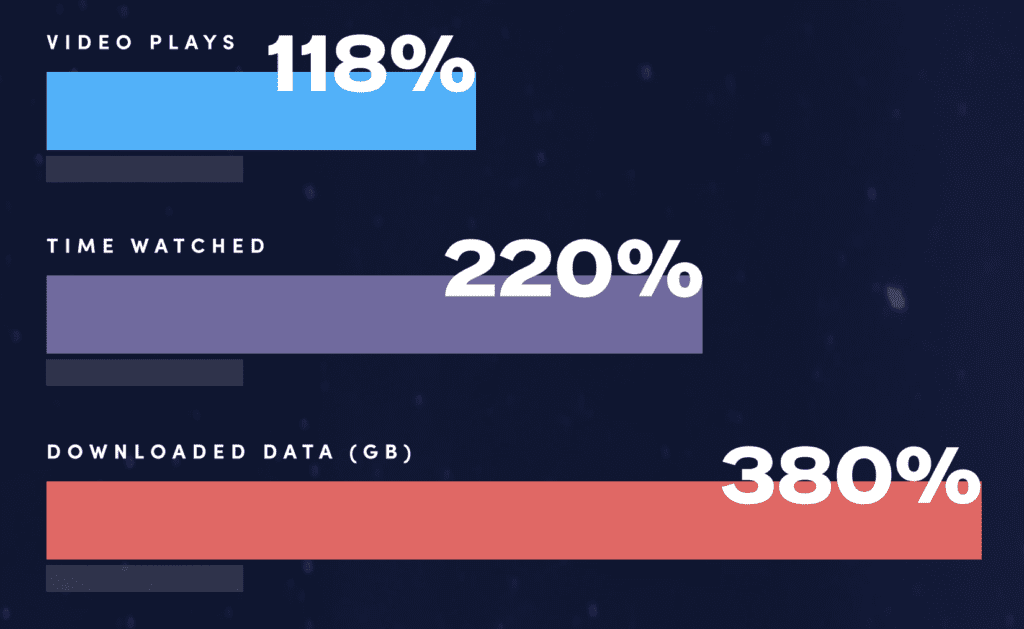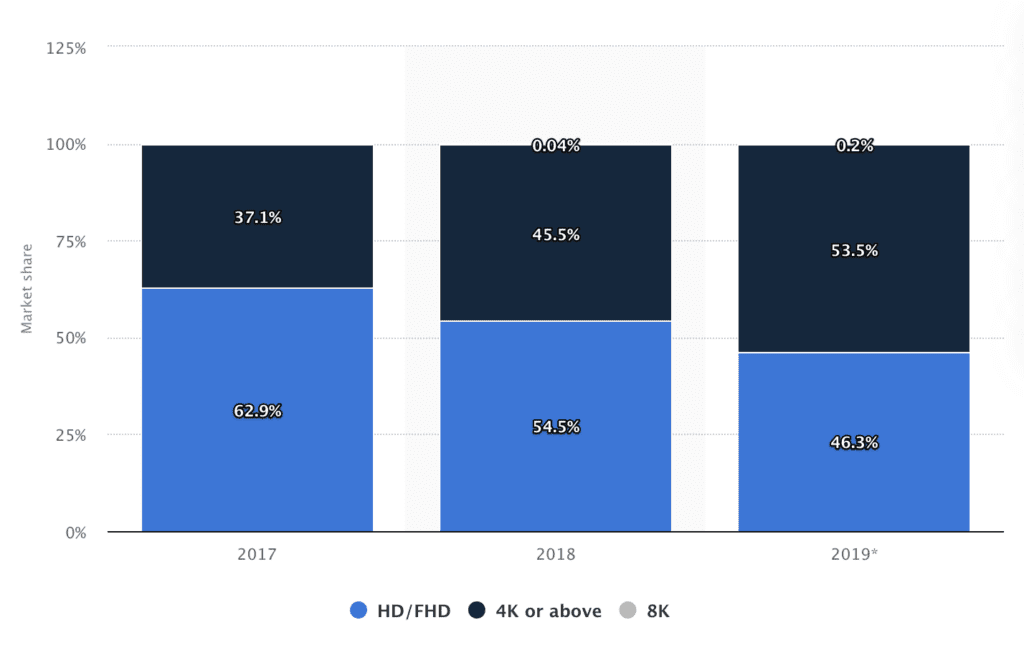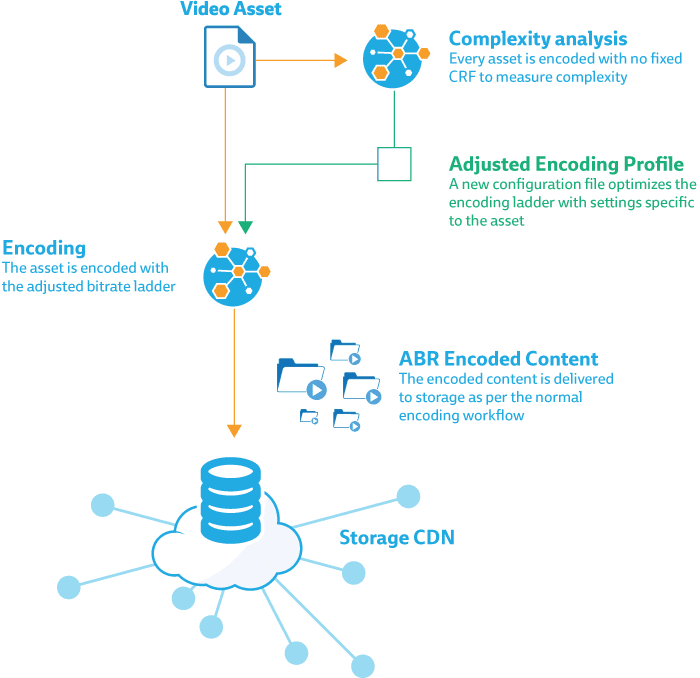
As of 2021, video technology has gained tremendous popularity, with no clear indication of slowing growth. With roughly 82% of consumers (in the US) owning at least one internet-connected device and 60% of adults watching a video on a connected device, it’s clear that a vast majority of individuals are seeking an engaging video experience. However, connected TV experiences aren’t the only developments within the video, technology, and streaming space. The latest streaming innovations are a mix of seen and unseen creations to the end-consumer that have an adverse effect on business operations. From the consumer-facing side, devices are delivering higher quality content, more engaging experiences, and at breakneck speeds.
The pandemic has taken a toll on our social lives. But, the same pandemic has yielded a massive increase in video consumption with minimal UX/UI charges on the top OTT platforms. In fact, Bitmovin’s customer base saw massive increases across video plays, total time watch, and downloaded data during the peak of the pandemic, over the same time period the previous year.

In addition to the growth that major streaming organizations experiences, smaller and mid-market businesses, such as local filmmakers, short filmmakers, serial makers that account for well over 100 available services worldwide (not even counting eLearning, eSports, and other eFitness streaming services) were able to come together to release new and improved productions across various OTT platforms.
According to a recent report from the Leichtman Research Group, as many as 82% of US households have at least one streaming service in their home. To ensure that modern viewers maintain a high quality of experience, it’s imperative for the video technology sector to stay innovative and engaged with its end consumers. To do so, the industry is addressing streaming innovation across two fronts:
- Better overall experiences for new users with new consumer-facing features
- Improved back-end workflows that increase operational efficiency
Better overall experiences for new users with new consumer-facing features
We’ll begin by addressing four of the most exciting streaming innovations that promise to improve or bring the consumer quality of experience to a completely new level:
1. 4K+ Supported Virtual Reality Devices
Content providers aren’t the only industry to finally catch up to the consumer craze of 4K quality devices. As of 2021, 4K supported headsets are now available at more cost-effective prices by major consumer electronics. Admittedly, the jury is still out on the success and quality of 8K headsets, but the prospect of more top-tier resolution devices is an exciting development for consumers and developers alike. Today, the burden rests on back-end technology to support the delivery of 8K quality content. We expect the adoption of future codecs, like VVC and LCEVC to enable the future success of 4K+ devices.
2. The Rise of Synchronized Viewing
Over the past 10 years, OTT platforms have taken over as a completely new type of social experience. Consumers were no longer restricted by broadcast viewing times or theaters to catch the next big film or TV series. With VoD available as an option, the concept of watch parties or the colloquial “Netflix and Chill” has risen. However, the pandemic of 2020/21 has yielded growth in the latest social viewing experience, “Synchronized Viewing,” wherein consumers view the same content at the same time and have some form of additional engagement with each other (ex: chat, video conferencing, etc).
Synchronized viewing initially grew on social media networks (with recent additions to LinkedIn), but exploded in popularity as people were unable to meet or go to live events and theaters with near and dear ones. At the time of this article, synchronized viewing is largely only possible (natively) on live sports apps, social networks, Disney +, and Twitch, but is supported via countless 3rd party apps (such as Teleparty, Kast, or Discord).
However, there this a trend that many streaming platforms are catching on to and plan to launch natively on their platforms as well. The benefit to most consumers is the new interactive social experience, and the benefit to streaming services is reduced pirating – as to join a synchronized viewing, you need to be signed in to the native app where concurrent viewers might be restricted.
3. Upscaling Content Resolutions

According to a recent report from Statista, as of 2019, 99.8% of global TV sales are in HD quality or higher (with significant growth of 4K quality sets). However, HD and higher content have only existed for the past 10 years, anything before that is still SD. Most OTT platforms today, offer older content on our much higher quality device. To address the disparity in quality, streaming services like Netflix and Hulu are regularly upsampling content (using technology like Super Resolution) to improve the user experience by limiting the “background noise” for everyday users.
The most common approach to upsampling is the spatial methodology, where a low-resolution image is improved using a mathematical function that calculates a predicted high-resolution image by comparing similar low-resolution images.

4. 5G Network Adoption
Before consumers could even get tired of 4G, consumers and governments are seeing the launch of the newest and fastest network 5G. Both consumers and developers are always chasing low latency streaming opportunities, with standardized 5G around the world, the burden of delivering high-quality content is lifted slightly off of the shoulders of OTT and streaming service providers. However, the combination of faster internet speeds, cloud-based per-title encoding solutions, and new codecs will ensure that no one experiences the dreaded buffering symbol again.
Streaming innovations that improve back-end workflows that increase operational efficiency
When it comes to enhanced workflow and efficiency, SaaS and B2B companies are developing countless new back-end technologies:
1. Adopting SMPTE 2110 to Bring Broadcast Online
Broadcast content is one of the oldest methods of consuming/distributing content. Today, the broadcast industry is slightly behind that of the OTT big hitters. To match the quality and speed of OTT delivery workflows, the Society of Motion Picture and Television Engineers (SMPTE) develops the latest back-end tech to support video delivery over IP. The latest set of standards known as SMPTE ST 2110, offer additional flexibility compared to SDI connectivity by specifying how to deliver compressed and uncompressed video and audio streams (amongst many other improvements).
2. Dynamic Ad Insertion (DAI) Technology Improvements
Dynamic Ad Insertion (DAI) is not new in the technology or even in the video market, ad insertions have been customizable since YouTube truly became an AVoD platform nearly 10 years. However, the innovations in DAI lie in their latency and customization capabilities, both of which are heavily influenced by the AI that’s built into each part of the DAI workflow. The latest DAI implementations use consumer information in a more efficient manner to deliver ads that relevant not only to the viewer but to the viewed content as well. From the latency perspective, DAI’s that implement proper encoding workflows perform better as they don’t interrupt the streaming experience with lower quality resolution or buffering/
3. Context Adaptive Content Delivery Workflows
Context Adaptive Content Delivery Workflows, otherwise known as CAD, employ a lot of different methodologies towards an optimal end-user experience. The most well-known method is the application of an Adaptive Bitrate Ladder (ABR), where content is compressed (encoded) and delivered at the ideal resolution at a given bitrate expenditure. The true streaming innovations in the space lie within the various technologies that actually apply ABR throughout their workflows. Technology like future codecs (such as AV1, HEVC, and VVC) and cloud-based per-title/per-shot/per-scene encoding that adapts lossy compression methods to not only the delivered content types but also the specific shots or sequences within a piece of content.

Technology like Cloud-Based Per-Title Encoding will help you provide the viewers with excellent streaming quality. Moreover, you can reduce costs of both storage and streaming of videos with this technological innovation.
4. Immersive Experiences with Dolby Vision and Atmos
Dolby has always been at the forefront of creating immersive experiences with its surround sound devices and technologies. Dolby Atmos takes surround sound to the next level by adding in better audio depth and spatial metadata, enabling a completely immersive sound experience. To complete the feeling of being inside the content your consuming, Dolby Vision enables a higher range of color, depth, sharpness, and contrast to your video.
Conclusion
A lot of innovation is born out of struggle and conflict, much of which is true of the video, technology, and streaming sector for the early 2020s as a result of the global pandemic. However, video technology is constantly evolving to match consumer demand and the creativity of individuals and organizations alike. Today, we’re seeing the development of new virtual (video-based) social experiences, faster content delivery workflows, and services that bring the highest quality content on any device at nearly any bandwidth. We eagerly await the next wave of streaming innovations, be it higher quality VR/AR/3D video content experiences, faster networks, or something completely inconceivable today.



